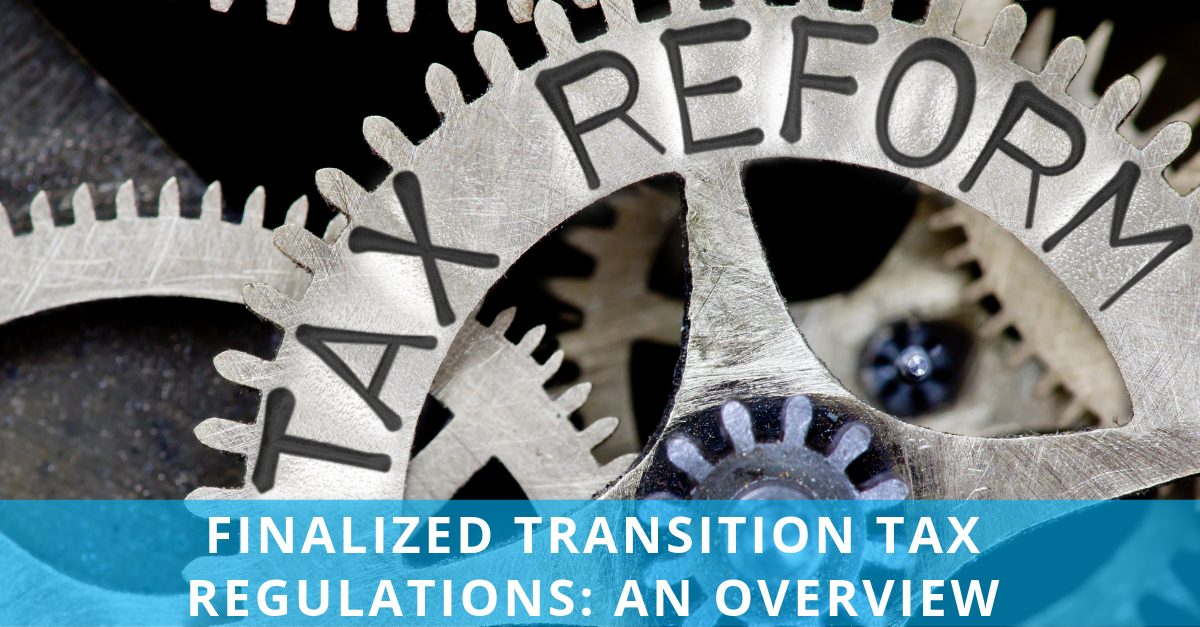The IRS has issued highly anticipated final regulations under Internal Revenue Code Section 965, the Transition Tax (TT) provision added by the Tax Cuts and Jobs Act (TCJA). Sec. 965 generally requires U.S. shareholders to pay a “transition tax” on the untaxed foreign earnings of certain specified foreign corporations (SFC) as if those earnings had been repatriated to the United States.
The TCJA provides for a shift from the pre-2018 “worldwide” tax system to a “participation exemption system.” Under the old rules, U.S. taxpayers were generally taxed on all income whether earned in the U.S. or abroad, but foreign income earned by a foreign subsidiary of a U.S. corporation wouldn’t be subject to U.S. tax on that income until it was “repatriated” to the United States via dividend. The transition tax effectively bridges the old rules with the new by taxing certain previously untaxed foreign income. Unfortunately for individual owners of SFC, there is no “transition”; only a deemed repatriation of old retained earnings and then the same tax on future dividends from future earnings!
Affected Income
In a SFC’s last tax year that began before January 1, 2018, the foreign corporation’s subpart F income is increased by any previously untaxed, post-1986 earnings and profits (E&P) of the corporation. This is measured as of one of two measuring dates. U.S. shareholders of one or more SFCs must include in income their pro rata share of the corporation’s pre-2018 accumulated deferred foreign income less their pro rata share of any other SFCs’ E&P deficits. A corporate U.S. shareholder is allowed a deduction from this amount that results in a 15.5% tax rate for earnings held in cash and liquid assets, and an 8% tax rate on other earnings. The rate for an individual US Shareholder is higher: 17.5% and 9%, respectively.
Taxpayers may elect to pay the TT in installments over an eight-year period. Generally, an SFC means either a controlled foreign corporation (CFC) or a foreign corporation (other than a passive foreign investment company) with a U.S. shareholder that’s a US domestic corporation.
Taxpayers may have had to already pay tax resulting from Sec. 965 when filing their 2017 tax returns. For example, Sec. 965 may have given rise to a 2017 tax liability for a calendar-year U.S. shareholder holding an interest in a calendar-year SFC.
Revision Highlights
Proposed regs under Sec. 965 were published in August 2018. The new final regs retain the basic approach and structure of the proposed regs, with certain revisions. Here are some highlights:
Cash position. A U.S. shareholder that is required to include a Sec. 965(a) inclusion amount in income may deduct, in the tax year of the inclusion amount, a “Section 965(c) deduction amount” equal to the sum of:
- The shareholder’s 8% rate equivalent percentage of the excess (if any) of the Sec. 965(a) inclusion amount over the amount of such shareholder’s “aggregate foreign cash position,” plus
- The shareholder’s 15.5% rate equivalent percentage of so much of the U.S. shareholder’s “aggregate foreign cash position” as doesn’t exceed the Sec. 965(a) inclusion amount.
The cash position of any specified foreign corporation is the sum of three items:
- Cash held by the corporation,
- The net accounts receivable of the corporation, and
- The fair market value of the certain “cash equivalent” assets held by the corporation, including:
- Personal property that is of a type actively traded and for which there is an established financial market,
- Commercial paper, certificates of deposit, the securities of the federal government and of any state or foreign government,
- Any foreign currency,
- Any short-term obligation with a term of less than one year, and
- Other “economically equivalent” assets.
However, the amounts of these cash equivalents aren’t considered by a U.S. shareholder in determining its aggregate foreign cash position to the extent that the shareholder demonstrates to the IRS that these amounts are considered by the shareholder with respect to another SFC.
The final regs generally retain the definitions of “aggregate foreign cash position” and “cash position” set out in the proposed regs. But the IRS has determined that a narrow exemption from the definition of “cash position” is appropriate for certain assets held by a specified foreign corporation in the ordinary course of its trade or business, as well as for certain privately negotiated contracts to buy or sell such assets.
Pro rata share. Under Sec. 958(a), a U.S. shareholder’s pro rata share of the Sec. 965(a) earnings amount is the portion of the Sec. 965(a) earnings amount that would be treated as distributed to the Sec. 958(a) U.S. shareholder under Sec. 951(a)(2)(A) and other regs. This would be determined as of the last day of the inclusion year of the deferred foreign income corporation (DFIC). The IRS has determined that this definition is inconsistent with the statutory language of Sec. 951 and Sec. 965 in the case in which an SFC, whether it is or is not a CFC, ceases to be an SFC during its inclusion year.
Because a SFC is treated as a CFC for purposes of Sec. 951, the IRS has determined that the final regs should be consistent with Sec. 951 in requiring a Sec. 965(a) inclusion by such a Sec. 958(a) U.S. shareholder. Accordingly, the definitions of “pro rata share” and “Section 958(a) U.S. shareholder inclusion year” are revised in the final regs.
The proposed regs provided that, for purposes of determining a Sec. 958(a) U.S. shareholder’s pro rata share of a specified E&P deficit of an E&P deficit foreign corporation, the specified E&P deficit is allocated among the shareholders of the corporation’s common stock in proportion to the value of the common stock held by such shareholders.
The IRS has determined that a specified E&P deficit should be allocated to shareholders of an E&P deficit corporation’s preferred stock in cases involving common stock with no liquidation value. Accordingly, the final regs provide that any amount of a specified E&P deficit that would otherwise be allocated in a hypothetical distribution to a class of common stock that has no liquidation value is instead allocated to the most junior class of equity with a positive liquidation value to the extent of the liquidation value.
The final regs also provide that, in cases in which a corporation’s common stock has a liquidation value of zero and there’s no class of equity with a liquidation preference relative to the common stock, the specified E&P deficit is allocated among the common stock using any reasonable method consistently applied.
Attribution rules in determining a specified foreign corporation. The proposed regs provided a special attribution rule in determining whether a foreign corporation is an SFC solely because of downward attribution of its stock under Sec. 318(a)(3)(A) from a partner to a partnership when the partner has only a de minimis interest in the partnership. The IRS notes that downward attribution of stock to a trust from de minimis beneficiaries of the trust presents similar administrative and compliance difficulties to those addressed in the proposed regs. Accordingly, the final regs extend the special rules concerning downward attribution (as modified) to trusts.
In addition, the final regs increase the threshold for application of this special attribution rule for partnerships from 5% to 10%. Similarly, the final regs use a 10% threshold for the newly added special attribution rule for trusts.
Important Changes
Moore Stephens Doeren Mayhew has been following these new provisions closely, especially as they relate to individuals who own SFCs (and CFCs). There are several new forms that must now be completed on a going forward basis related to the TT, even if initially reported in your 2017 income tax returns. We would be pleased to discuss these new forms, including the additional reporting required, and determine how best to comply in an efficient manner.
 Grensy Quintero, CPA contributed to this article.
Grensy Quintero, CPA contributed to this article.





